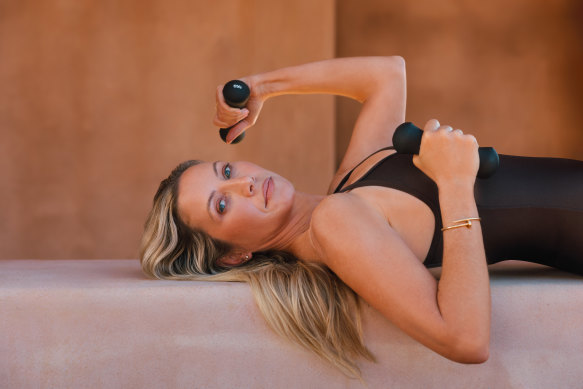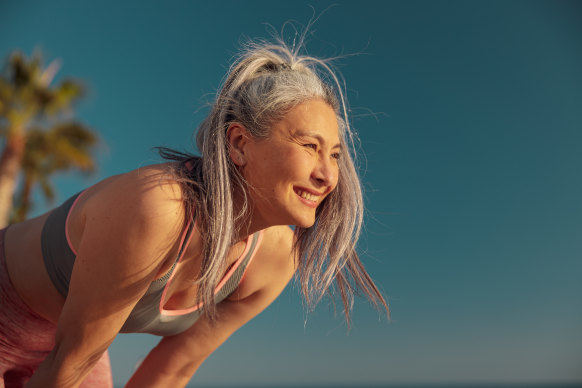This was published 4 months ago
Why women need to change how they move into menopause
By Sarah Berry
In the 13 years since Kirsten King opened her first Fluid Form Pilates studio in Sydney, she’s seen that what once worked for clients no longer seems to be effective.
“They need to be doing different types of exercise,” says King, who is in her 40s and launched an online program in June for women, with a focus on plyometrics and weight-bearing exercise. “If women feel strong and have those endorphins happening, they’re just in a better frame of mind.”
Fifty per cent of the world’s population goes through the “critical period” of change that is perimenopause and menopause.

Kirsten King.
Though exercise may be the best non-pharmacological way to address the risk factors and symptoms that come with declining oestrogen, little is known about what type is the most effective. But slowly a picture is starting to emerge that challenges conventional wisdom that, as we age, we ought to slow down.
The physical activity guidelines for adults recommend 30 minutes of moderate-intensity activity a day. As hormonal changes during perimenopause and menopause cause declines in bone density and muscle mass while increasing baseline cortisol levels and the likelihood of injury, the typical advice is to opt for low-impact, low-stress forms of exercise such as aqua aerobics, brisk walking or yoga.

Dr Stacy Sims.
An increasing number of outliers ignore such advice and take up endurance sports, as our endurance peaks in our 40s, and psychologically it challenges narratives around the “decaying” and “menopausal” body.
Although any activity is good activity, some experts argue that moderate and endurance exercise may not be the most effective for combating two of the major concerns perimenopausal and menopausal women have: poor sleep and changing body composition.
Dr Stacy Sims, an exercise physiologist, nutrition scientist and expert in female-specific responses, was once a dedicated ultra-runner and cyclist.
Since the onset of perimenopause, 51-year-old Sims found that those activities made her feel “drained ... and gross” and no longer had the same effect on her body.
Based on her own experience, alongside an emerging body of literature, Sims believes that the long, moderate workout doesn’t provide the body with the stimulus needed to offset declining oestrogen.
What menopausal women need to prioritise, she suggests, is the strong external stimulus that comes from high-intensity interval training (HIIT) or the shorter, more intense sprint interval training (SIT). True HIIT is not to be confused with 45 or 60-minute classes marketed as HIIT, which have too many sets and insufficient recovery between them.
“If it’s done properly, it has a post-exercise response that increases growth hormone and increases testosterone, which brings cortisol down,” says Sims, adding that it invokes the parasympathetic response we need for sleep.
The work of Professor Abbie Smith-Ryan, director of the Applied Physiology Laboratory at North Carolina University, has explored the effects of HIIT and SIT on midlife women. She says just one HIIT session a week can result in positive adaptations – two to three is ideal.
HIIT and SIT activate mitochondrial changes which improve fat oxidation, the cardiovascular system, stimulate muscle and overcome metabolic inflexibility (the inability to switch fuel sources during exercise, which can be a contributor to weight gain).

Short bursts of more intense exercise can be phased in gradually.Credit: Getty Images
“This method of training can also target belly fat, which increases in perimenopause, [and] be better for injury prevention, as there is less time under tension/stress,” Smith-Ryan says. And it’s all in 10 minutes of work – 20 if you include recovery.
It does not mean women should not also do moderate or low-intensity exercise, she says: “But HIIT will definitely give women a bigger bang for their buck.”
Sims adds that, if someone is not exercising at all, then just starting to move regularly is most important. Short bursts of more intense exercise can be phased in gradually and need to be accompanied by mobility work and warming up.
“It takes longer to warm up now that we’re older,” says Sims. “My friends and I laugh, we want to go for a 20-minute run, but it takes us an hour and a half.”
Though Sims says the consensus is “building” that perimenopausal and menopausal women need separate physical activity guidelines, not everyone agrees.

New advice flies in the face of conventional wisdom.Credit: Getty Images
Dr Mandy Hagstrom, an accredited exercise scientist and researcher from UNSW, says each woman’s experience is different and can vary from day to day, particularly during perimenopause, when hormones can fluctuate wildly.
“The evidence we have is so all over the show we can’t synthesise it,” Hagstrom says. “Population-level advice will be challenging because variability between women is so big.”
What we do know, she says, is that exercise of any form can mitigate changes and symptoms resulting from menopause. Hagstrom doesn’t believe there is enough evidence to show HIIT and SIT are superior but agrees that we don’t have to become more moderate with age.
“Strength training would be my recommendation because muscle is linked with falls, metabolic control and body comp regulation,” she says, adding that only a quarter of women do two strength sessions a week. “It’s not inevitable that the change in hormones is going to rob your body of what it used to be.”
How to HIIT and SIT
HIIT and SIT intervals are typically 30-60 seconds each with equivalent recovery. The whole session rarely lasts more than 20 minutes. The modality doesn’t matter: intervals should be an eight or nine out of 10 in perceived effort and could involve box or squat jumps, medicine ball slams, kettlebell swings, battle ropes, lifting heavy weights (no more than six reps), cycling, sprinting or climbing stairs.
For those of us who enjoy longer, more moderate forms of exercise, Sims suggests incorporating a little SIT in the middle, for instance sprinting or going hard uphill for 20-30 seconds before going at a snail’s pace to recover.
Make the most of your health, relationships, fitness and nutrition with our Live Well newsletter. Get it in your inbox every Monday.